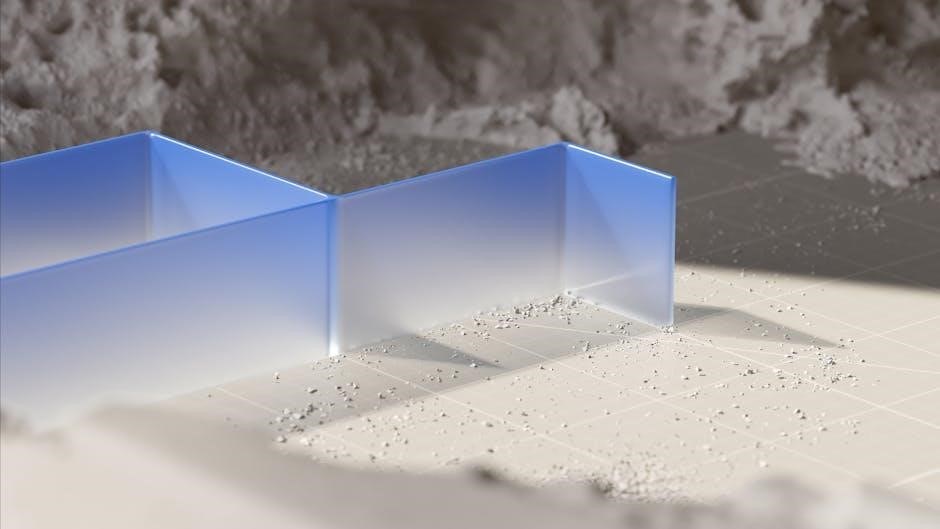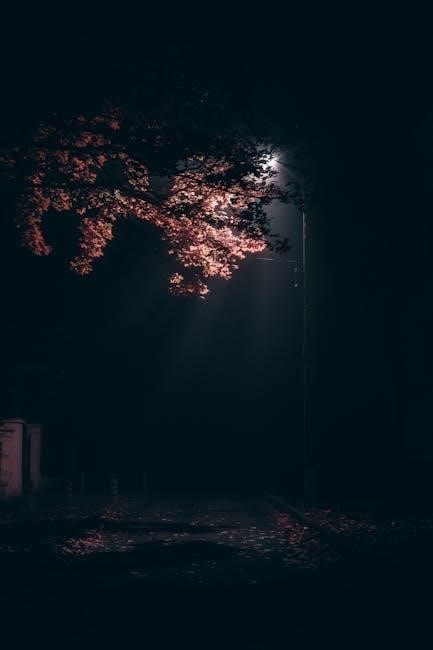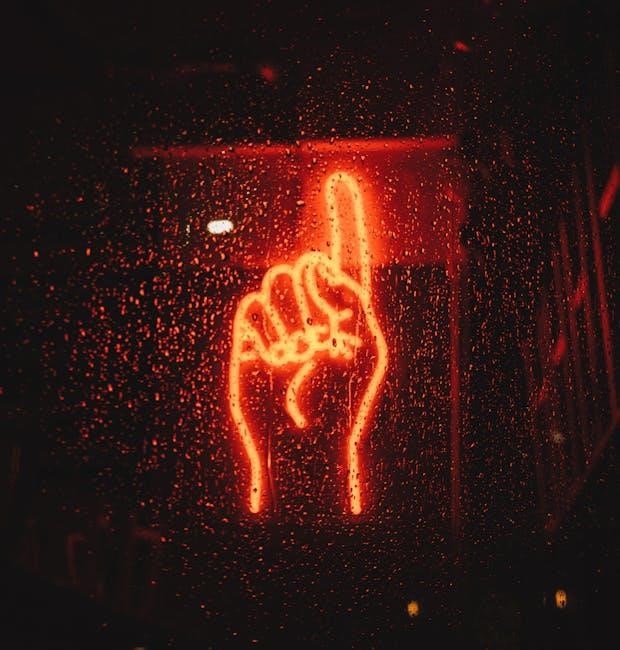Light is a fundamental element in visual arts, shaping form, mood, and emotional depth across painting, photography, and digital media. It enables artists to create realistic and fantastical effects through techniques like backlighting and sidelighting, as explored in resources such as Richard Yot’s comprehensive guide.
The Importance of Light in Creating Realistic and Fantastical Effects
Light is essential for crafting realistic and fantastical effects in visual arts, enabling artists to manipulate shadows, highlights, and textures. Techniques like backlighting and sidelighting create dramatic contrasts, while fill light enhances depth and dimension. These methods allow artists to sculpt forms, evoke emotions, and build immersive environments, whether depicting reality or fantasy. Proper lighting transforms ordinary subjects into extraordinary visual experiences, making it a cornerstone of artistic expression.
Light as the Foundation of Visual Art
Light serves as the cornerstone of visual art, defining form, texture, and mood while evoking emotional resonance. It breathes life into compositions, transforming two-dimensional surfaces into immersive experiences. Whether through subtle nuances or dramatic contrasts, light guides the viewer’s perception, creating depth and dimension. Its presence is indispensable, shaping the very essence of artistic expression across painting, photography, and digital media, making it a universal and fundamental element in the creative process.

Understanding Light Fundamentals
Light’s color, intensity, and direction are essential for creating depth, texture, and mood in art. These properties shape form and emotional impact across visual media.
Properties of Light: Color, Intensity, and Direction
Light’s properties—color, intensity, and direction—are vital in visual arts. Color evokes emotions and sets the tone, while intensity creates contrast, defining highlights and shadows. Direction determines form and depth, with techniques like backlighting and sidelighting enhancing dimensionality. Mastering these elements allows artists to manipulate perception, creating dynamic, emotionally resonant compositions. Understanding light’s properties is foundational for achieving realism and artistic expression across various mediums.
Types of Lighting Techniques: Backlighting, Sidelighting, and Fill Light
Backlighting creates dramatic silhouettes and highlights contours, while sidelighting emphasizes texture and form, adding depth. Fill light softens shadows, balancing contrast and enhancing detail. These techniques, often used in painting and photography, help artists control mood and focus. Mastering backlighting, sidelighting, and fill light enables the creation of dynamic, visually engaging compositions that guide the viewer’s eye and evoke emotional responses.
The Role of Light in Different Visual Media
Light plays a crucial role in painting, photography, and digital art, shaping depth, mood, and texture. It enhances storytelling and visual impact across mediums, inspiring creativity.
Lighting in Painting: Techniques for Depth and Mood
Lighting in painting is essential for creating depth, dimension, and emotional resonance. Techniques like chiaroscuro use strong contrasts to define form, while subtle gradients evoke softness. Backlighting and sidelighting enhance texture and contours, adding drama; Artists manipulate light intensity and direction to guide the viewer’s eye, evoking specific moods. High-key lighting creates brightness and serenity, while low-key lighting builds mystery and tension, as seen in works by masters like Rembrandt and da Vinci.
Lighting in Photography: Manipulating Aperture, Shutter Speed, and ISO
Photographers masterfully control light by adjusting aperture, shutter speed, and ISO. Aperture regulates depth of field, while shutter speed captures motion or freeze frames. ISO sensitivity balances brightness without overexposure. These settings, combined with techniques like backlighting and sidelighting, enable photographers to create dynamic compositions. Proper manipulation enhances texture, contrast, and mood, transforming ordinary scenes into extraordinary visual narratives, as explored in resources like Richard Yot’s guide for visual artists.
Lighting in Digital Art: Using Ambient Occlusion and 3D Techniques
Digital artists utilize ambient occlusion to simulate indirect lighting, enhancing depth and realism in their work. This technique subtly adds shadows, creating more natural-looking environments. Combined with 3D lighting tools, artists can precisely control light direction, intensity, and color to achieve dramatic effects and texture. These techniques enable the creation of immersive digital scenes, allowing artists to experiment and innovate, thereby advancing the possibilities of visual expression and engagement in digital art.
Lighting Techniques for Specific Effects
Techniques like backlighting and sidelighting create contrast, while fill light enhances texture. Dramatic shadows add depth, shaping form and mood in artistic compositions effectively.
Creating Contrast: Sculpting Forms with Highlights and Shadows
Contrast is achieved by balancing highlights and shadows to define form and depth. Strong highlights sculpt shapes, while deep shadows add dimension and drama. Techniques like backlighting and sidelighting emphasize texture and create striking visual effects. Dramatic shadows enhance the three-dimensional quality of subjects, guiding the viewer’s eye. This interplay of light and dark transforms flat compositions into dynamic, lifelike representations, essential for capturing realism and evoking emotion in art.
Using Light to Evoke Emotions and Set the Mood
Light is a powerful tool for evoking emotions and setting the mood in visual art. Soft, diffused light creates a calm and serene atmosphere, while intense, directional light can convey drama or tension. Techniques like backlighting and sidelighting enhance emotional depth, guiding the viewer’s perception. Bright, warm tones often symbolize energy or joy, whereas cool, subdued lighting can evoke melancholy or mystery. Artists strategically manipulate light to connect with the audience on an emotional level.
Enhancing Texture and Form with Dramatic Shadows
Dramatic shadows add depth and dimension to visual art, accentuating texture and form. Strong directional lighting creates sharp contrasts, emphasizing intricate details and adding emotional intensity. Techniques like chiaroscuro and ambient occlusion enhance the three-dimensional quality of subjects. Shadows guide the viewer’s eye, creating visual interest and depth. This interplay of light and dark transforms flat compositions into immersive experiences, making texture and form more engaging and lifelike.

Practical Applications of Lighting in Art
Artists use light studies and practical tools to observe and sketch light in various conditions, enhancing their ability to create realistic effects in both traditional and digital media.
Light Studies: Observing and Sketching Light in Different Conditions
Light studies involve dedicated observation and sketching of light behavior under various conditions. Artists practice capturing its color, intensity, and direction to understand its impact on form and mood. By documenting natural and artificial light, they develop techniques to replicate realistic effects in their work. These studies are foundational for mastering lighting in both traditional and digital art forms, as emphasized in resources like Richard Yot’s guide for visual artists.
Tools for Lighting in Digital and Traditional Art
Artists utilize various tools to master lighting techniques. Traditional tools include brushes, colored pencils, and chiaroscuro sketches, while digital artists rely on software like Adobe Photoshop and 3D modeling programs. Ambient occlusion and layer blending modes enhance depth and realism. These tools help create dynamic contrasts, textures, and moods, bridging the gap between observation and artistic expression, as detailed in guides like Richard Yot’s “Light for Visual Artists.”
Famous Artists and Their Use of Light
Famous artists like Rembrandt and Vermeer harnessed light to create dramatic effects, as seen in their masterpieces. Their techniques inspire modern artists, as noted in Richard Yot’s guide.
Masterpieces That Showcase Exceptional Lighting Techniques
Masterpieces like Rembrandt’s The Night Watch and Vermeer’s Girl with a Pearl Earring exemplify exceptional lighting techniques. Rembrandt’s use of chiaroscuro creates dramatic contrasts, while Vermeer’s soft, diffused light evokes serenity. These works highlight how lighting can transform a scene, adding depth and emotion. Such masterpieces, analyzed in resources like Richard Yot’s guide, inspire artists to experiment with light for impactful visual storytelling and atmospheric effects in their own creations.
Learning from the Works of Renowned Visual Artists
Studying masterpieces by artists like Rembrandt and Vermeer reveals their mastery of light. Rembrandt’s chiaroscuro and Vermeer’s subtle use of natural light demonstrate how to evoke emotion and depth. Analyzing these works, as discussed in resources like Richard Yot’s guide, helps artists understand the nuances of lighting. By learning from these masters, contemporary artists can refine their techniques, ensuring light enhances their compositions and conveys intended moods effectively in their own creative projects.
Challenges and Solutions in Lighting
Common lighting challenges include managing intensity and color consistency. Solutions involve using tools like ambient occlusion and ensuring proper equipment setup for desired effects.
Common Mistakes Artists Make with Lighting
Artists often overlook the importance of ambient light, leading to unrealistic shadows. Overuse of dramatic lighting can distract from the subject, while improper backlighting may flatten forms. Neglecting to study natural light conditions results in unconvincing effects. Many artists also struggle with balancing contrast, causing loss of detail in highlights or shadows. Understanding light behavior through observation and practice is key to avoiding these pitfalls and achieving cohesive, impactful lighting in their work.
Overcoming Lighting Challenges in Different Art Forms
Overcoming lighting challenges requires mastering techniques like backlighting and sidelighting to enhance form and texture. Observing natural light helps artists create realistic effects. Photographers adjust aperture and shutter speed to control light, while digital artists use tools like ambient occlusion for depth. Practice and consistent study of light behavior are essential to balance contrast and avoid distractions, ensuring cohesive and impactful lighting across various art forms effectively.

Future Trends in Lighting for Visual Artists
Emerging technologies like real-time lighting tools and AI-driven software are revolutionizing visual arts. Artists can now experiment with dynamic lighting effects in virtual reality and augmented reality, enabling immersive storytelling and unparalleled creative expression.
Emerging Technologies and Their Impact on Artistic Lighting
Advancements in real-time lighting tools and AI-driven software are transforming artistic practices. Artists can now achieve dynamic, lifelike illumination in digital art using technologies like ambient occlusion and 3D rendering. Virtual reality and augmented reality also enable immersive lighting experiments, allowing creators to craft intricate, interactive environments. These innovations not only enhance efficiency but also open new avenues for creative expression, blending technical precision with artistic vision.
Evolution of Lighting Techniques in the Digital Age
The digital age has revolutionized lighting techniques, enabling artists to achieve unprecedented realism and creativity. Tools like 3D rendering and real-time lighting software allow for precise control over illumination. Ambient occlusion and global illumination enhance depth and realism in digital art. Additionally, AI-powered tools now assist in simulating complex lighting scenarios, making it easier for artists to experiment and innovate. These advancements have transformed traditional lighting principles into dynamic, interactive experiences.

Additional Resources for Learning
Essential resources include Richard Yot’s “Light for Visual Artists” and James Gurney’s “Color and Light.” Online tutorials, forums, and downloadable PDFs offer practical insights and techniques for artists.
Recommended Books and Tutorials on Lighting for Artists
Richard Yot’s “Light for Visual Artists” is a comprehensive guide offering insights into lighting techniques for realistic and fantastical effects. James Gurney’s “Color and Light” explores color theory and lighting principles. Online tutorials and downloadable PDFs, such as those from platforms like Z-lib.org, provide practical lessons and inspiration. These resources are invaluable for artists seeking to master lighting in painting, photography, and digital art.
Online Communities and Forums for Sharing Lighting Techniques
Online platforms like Reddit, Quora, and specialized art forums offer vibrant spaces for artists to exchange lighting techniques. Communities on these sites share insights, tutorials, and resources, fostering collaboration. Websites like Z-lib.org and Internet Archive host free PDFs and e-books, such as Richard Yot’s “Light for Visual Artists,” providing accessible learning materials. These forums empower artists to refine their skills and stay updated on emerging trends in lighting for visual arts.
Light is the cornerstone of visual arts, enabling artists to craft realistic and emotionally resonant works. Mastering its techniques empowers creators to elevate their art, as seen in resources like Richard Yot’s guide, inspiring endless experimentation and innovation in the ever-evolving world of visual expression.
Summarizing the Key Concepts of Effective Lighting in Art
Effective lighting in art is pivotal for shaping form, mood, and emotional depth. Techniques like backlighting and sidelighting enhance dimension and drama, while tools such as ambient occlusion refine texture. Mastery of light, as explored in resources like Richard Yot’s guide, empowers artists to create realistic and fantastical effects. Understanding light’s properties—color, intensity, and direction—allows for deliberate manipulation of shadows and highlights, fostering dynamic compositions that resonate deeply with viewers and elevate visual storytelling.
Encouraging Artists to Experiment and Innovate with Light
Artists should embrace light as a dynamic tool for creativity. Experimenting with backlighting, sidelighting, and fill light can unlock unique effects. Exploring ambient occlusion and 3D techniques in digital art adds depth. Studying masterpieces and modern resources, like Richard Yot’s guide, inspires innovation. Encourage pushing boundaries by playing with highlights, shadows, and color to evoke emotions and create captivating visual experiences that redefine artistic expression and engage audiences on a deeper level.
